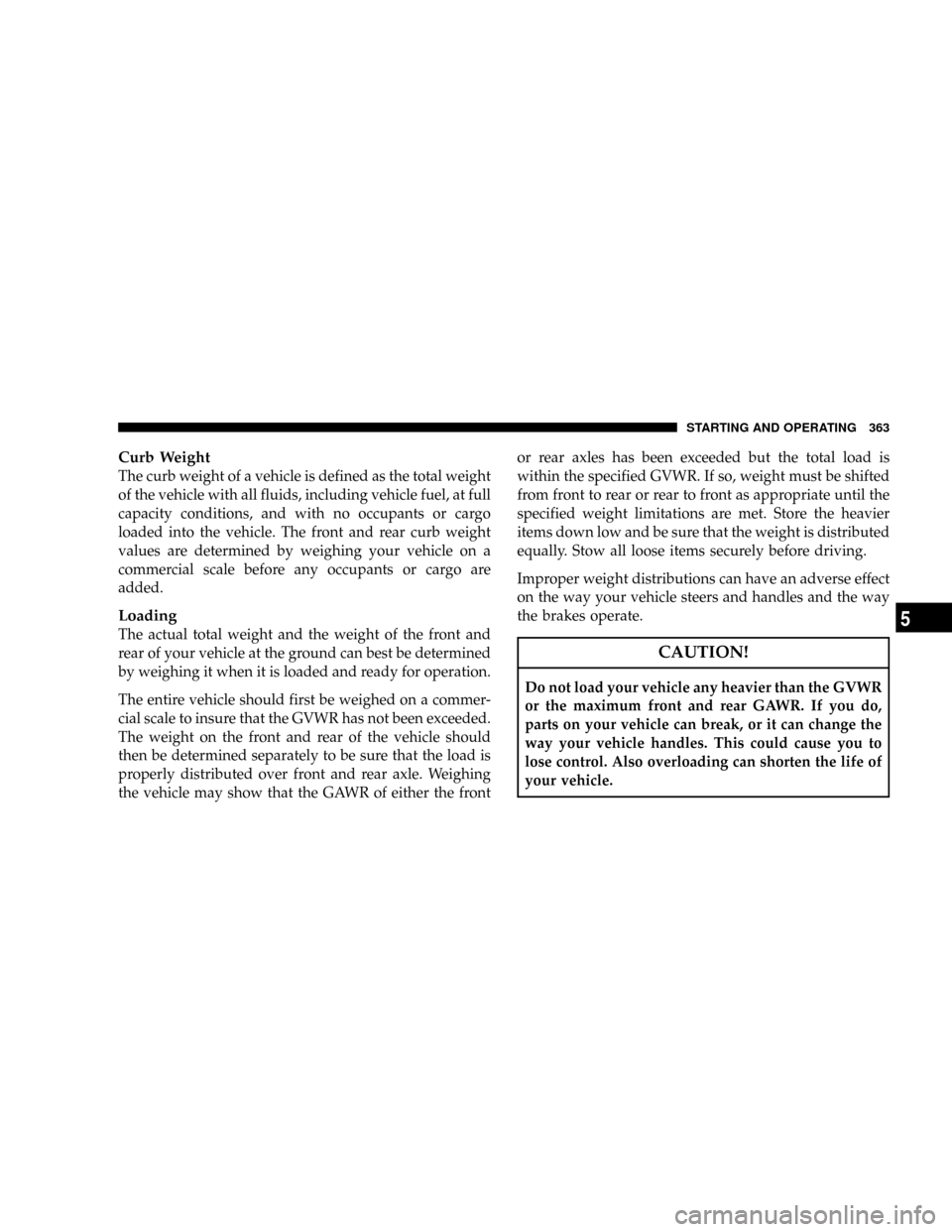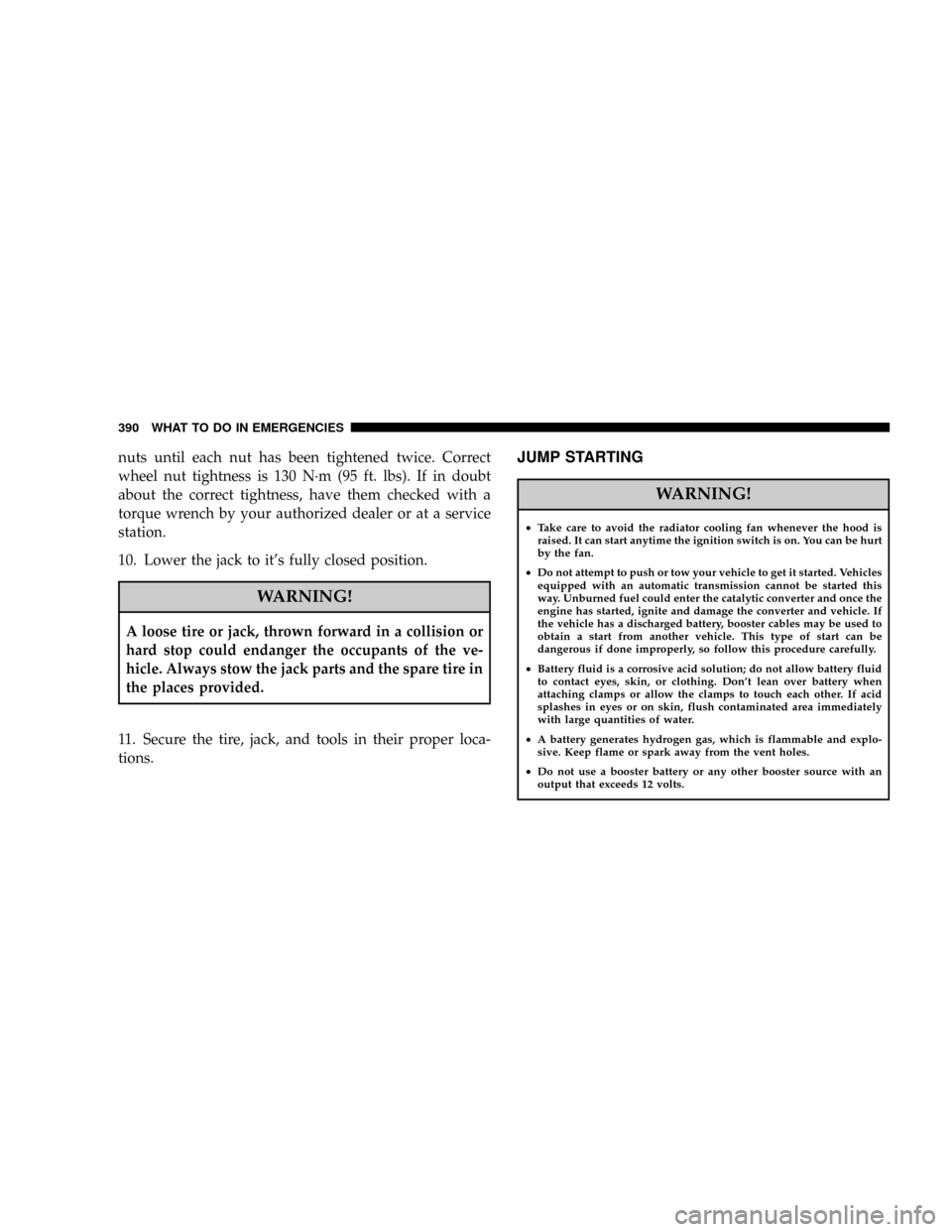Page 360 of 493
CAUTION!
²Damage to the fuel system or emission control
system could result from using an improper fuel
tank filler tube cap (gas cap).
²A poorly fitting gas cap could let impurities into
the fuel system.
²A poorly fitting gas cap may cause the Malfunc-
tion Indicator Light to turn on.
²To avoid fuel spillage and overfilling, do not ªtop
offº the fuel tank after filling. When the fuel
nozzle ªclicksº or shuts off, the fuel tank is full.
WARNING!
²Never have any smoking materials lit in or near
the vehicle when the gas cap is removed or the
tank filled.
²Never add fuel to the vehicle when the engine is
running.
²A fire may result if gasoline is pumped into a
portable container that is inside of a vehicle. You
could be burned. Always place gas containers on
the ground while filling.
360 STARTING AND OPERATING
Page 361 of 493

NOTE:
²Tighten the gas cap until you hear a ªclickingº sound.
This is an indication that the gas cap is tightened
properly. The Malfunction Indicator Light in the in-
strument cluster may turn on if the gas cap is not
secured properly. Make sure that the gas cap is tight-
ened each time the vehicle is refueled.
²When the fuel nozzle ªclicksº or shuts off, the fuel
tank is full.
Loose Fuel Filler Cap Message
If the vehicle diagnostic system determines that the fuel
filler cap in loose, improperly installed, or damaged, a
ªgASCAPº message will display in the instrument clus-
ter. Tighten the gas cap until a ªclickingº sound is heard.
This is an indication that the gas cap is properly tight-
ened. Press the trip odometer reset button to turn off the
message. If the problem persists, the message will appear
the next time the vehicle is started. This might indicate adamaged cap. If the problem is detected twice in a row,
the system will turn on the Malfunction Indicator Light
(MIL). Resolving the problem will turn the MIL light off.
VEHICLE LOADING
Certification Label
As required by National Highway Traffic Safety Admin-
istration Regulations, your vehicle has a certification
label affixed to the driver's side door or pillar.
This label contains the month and year of manufacture,
Gross Vehicle Weight Rating (GVWR), Gross Axle Weight
Rating (GAWR) front and rear, and Vehicle Identification
Number (VIN). A Month-Day-Hour (MDH) number is
included on this label and indicates the Month, Day, and
Hour of manufacture. The bar code that appears on the
bottom of the label is your Vehicle Identification Number
(VIN).
STARTING AND OPERATING 361
5
Page 363 of 493

Curb Weight
The curb weight of a vehicle is defined as the total weight
of the vehicle with all fluids, including vehicle fuel, at full
capacity conditions, and with no occupants or cargo
loaded into the vehicle. The front and rear curb weight
values are determined by weighing your vehicle on a
commercial scale before any occupants or cargo are
added.
Loading
The actual total weight and the weight of the front and
rear of your vehicle at the ground can best be determined
by weighing it when it is loaded and ready for operation.
The entire vehicle should first be weighed on a commer-
cial scale to insure that the GVWR has not been exceeded.
The weight on the front and rear of the vehicle should
then be determined separately to be sure that the load is
properly distributed over front and rear axle. Weighing
the vehicle may show that the GAWR of either the frontor rear axles has been exceeded but the total load is
within the specified GVWR. If so, weight must be shifted
from front to rear or rear to front as appropriate until the
specified weight limitations are met. Store the heavier
items down low and be sure that the weight is distributed
equally. Stow all loose items securely before driving.
Improper weight distributions can have an adverse effect
on the way your vehicle steers and handles and the way
the brakes operate.
CAUTION!
Do not load your vehicle any heavier than the GVWR
or the maximum front and rear GAWR. If you do,
parts on your vehicle can break, or it can change the
way your vehicle handles. This could cause you to
lose control. Also overloading can shorten the life of
your vehicle.
STARTING AND OPERATING 363
5
Page 378 of 493

þUse speed control in flat terrain and with light loads to
maximize fuel efficiency.
Towing Tips Ð Cooling System
To reduce potential for engine and transmission over-
heating, take the following actions:
þCity Driving
When stopped for short periods of time, put transmission
in neutral and increase engine idle speed.
þHighway Driving
Reduce speed.
þAir Conditioning
Turn off temporarily.
þRefer to ªCooling Systemº under ªMaintenance Pro-
ceduresº in Section 7 of this manual for more informa-
tion.
RECREATIONAL TOWING (BEHIND
MOTORHOME, ETC.)
Towing ± 2WD Models
Recreational towing is not allowed.
CAUTION!
Towing with the rear wheels on the ground can result
in severe transmission damage.
Towing Ð 4WD Models
The transfer case must be shifted into Neutral (N) for
recreational towing. The Neutral (N) selection button is
located at the top of the 4WD Control Switch. Shifts into
and out of transfer case Neutral (N) can take place with
the selector switch in any mode position.
378 STARTING AND OPERATING
Page 390 of 493

nuts until each nut has been tightened twice. Correct
wheel nut tightness is 130 N´m (95 ft. lbs). If in doubt
about the correct tightness, have them checked with a
torque wrench by your authorized dealer or at a service
station.
10. Lower the jack to it's fully closed position.
WARNING!
A loose tire or jack, thrown forward in a collision or
hard stop could endanger the occupants of the ve-
hicle. Always stow the jack parts and the spare tire in
the places provided.
11. Secure the tire, jack, and tools in their proper loca-
tions.
JUMP STARTING
WARNING!
²Take care to avoid the radiator cooling fan whenever the hood is
raised. It can start anytime the ignition switch is on. You can be hurt
by the fan.
²Do not attempt to push or tow your vehicle to get it started. Vehicles
equipped with an automatic transmission cannot be started this
way. Unburned fuel could enter the catalytic converter and once the
engine has started, ignite and damage the converter and vehicle. If
the vehicle has a discharged battery, booster cables may be used to
obtain a start from another vehicle. This type of start can be
dangerous if done improperly, so follow this procedure carefully.
²Battery fluid is a corrosive acid solution; do not allow battery fluid
to contact eyes, skin, or clothing. Don't lean over battery when
attaching clamps or allow the clamps to touch each other. If acid
splashes in eyes or on skin, flush contaminated area immediately
with large quantities of water.
²A battery generates hydrogen gas, which is flammable and explo-
sive. Keep flame or spark away from the vent holes.
²Do not use a booster battery or any other booster source with an
output that exceeds 12 volts.
390 WHAT TO DO IN EMERGENCIES
Page 395 of 493
MAINTAINING YOUR VEHICLE
CONTENTS
m3.7L Engine Compartment................398
mOnboard Diagnostic System Ð OBD II........399
NLoose Fuel Filler Cap Message............400
mEmissions Inspection And Maintenance
Programs............................400
mReplacement Parts......................402
mDealer Service.........................402
mMaintenance Procedures..................402
NEngine Oil..........................403NEngine Oil Filter......................405
NDrive Belts Ð Check Condition And Tension . . 406
NSpark Plugs.........................406
NEngine Air Cleaner Filter................406
NFuel Filter..........................407
NCatalytic Converter....................407
NCrankcase Emission Control System........409
NMaintenance-Free Battery................409
NAir Conditioner Maintenance.............411
7
Page 396 of 493

NA/C Air Filter Ð If Equipped............412
NPower Steering Ð Fluid Check............412
NDriveline And Steering Component
Lubrication..........................413
NBody Lubrication.....................413
NWindshield Wiper Blades................413
NWindshield & Rear Window Washers.......414
NExhaust System......................415
NCooling System.......................416
NHoses And Vacuum/Vapor Harnesses.......421
NFuel System.........................421
NBrake System........................422
NClutch Hydraulic System Ð Manual
Transmission (If Equipped)..............424NAutomatic Transmission................425
NManual Transmission Ð If Equipped.......426
NTransfer Case........................426
NFront/Rear Axle Fluid..................428
NAppearance Care And Protection From
Corrosion...........................428
mSky SlidertTopCare ....................434
NWashing............................434
NGeneral Cleaning.....................434
NAdditional Cleaning Procedure............435
NProtection...........................435
NWeather Strip Care....................436
mFuses (Integrated Power Module)...........436
396 MAINTAINING YOUR VEHICLE
Page 399 of 493

ONBOARD DIAGNOSTIC SYSTEM Ð OBD II
Your vehicle is equipped with a sophisticated onboard
diagnostic system called OBD II. This system monitors
the performance of the emissions, engine, and automatic
transmission control systems. When these systems are
operating properly, your vehicle will provide excellent
performance and fuel economy, as well as engine emis-
sions well within current government regulations.
If any of these systems require service, the OBD II system
will turn on the ªMalfunction Indicator Light.º It will
also store diagnostic codes and other information to
assist your service technician in making repairs. Al-
though your vehicle will usually be drivable and not
need towing, see your dealer for service as soon as
possible.CAUTION!
²Prolonged driving with the ªMalfunction Indica-
tor Lightº on could cause further damage to the
emission control system. It could also affect fuel
economy and driveability. The vehicle must be
serviced before any emissions tests can be per-
formed.
²If the ªMalfunction Indicator Lightº is flashing
while the engine is running, severe catalytic con-
verter damage and power loss will soon occur.
Immediate service is required.
MAINTAINING YOUR VEHICLE 399
7